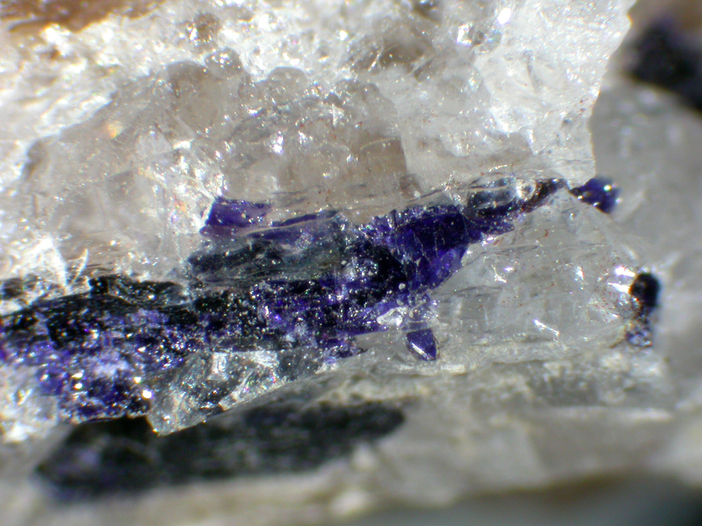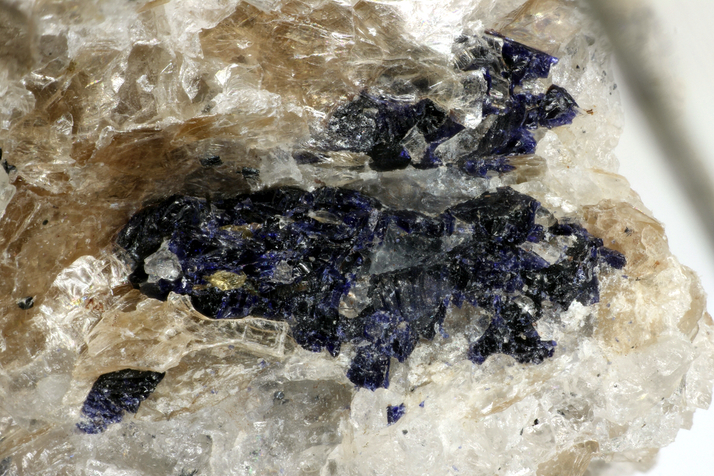Yoderite (original) (raw)
A valid IMA mineral species
About YoderiteHide
This section is currently hidden. Click the show button to view.
Formula:
Mg(Al,Fe3+)3(SiO4)2O(OH)
Colour:
Deep purple to dark violet, green (rare)
Crystal System:
Monoclinic
Name:
Named in 1959 by Duncan Mckie in honour of Hatten Schuyler Yoder, Jr. (20 March 1921, Cleveland, Ohio, USA - 2 August 2003, Bethesda, Maryland, USA), geophysicist and petrologist, 4th Director of the Geophysical Laboratory, Carnegie Institution of Washington (USA) from 1971 to 1986. He conducted pioneering work on minerals under high pressure and temperature. He was noted for his study of silicates and igneous rocks.
Unique IdentifiersHide
This section is currently hidden. Click the show button to view.
Long-form identifier:
mindat:1:1:4363:8
4d44bdc5-8b2d-4d73-817f-1b16b5a29c74
IMA Classification of YoderiteHide
This section is currently hidden. Click the show button to view.
IMA Formula:
(MgAl3)(MgAl)Al2O2(SiO4)4(OH)2
Type description reference:
Classification of YoderiteHide
This section is currently hidden. Click the show button to view.
9.AF.25
9 : SILICATES (Germanates)
A : Nesosilicates
F : Nesosilicates with additional anions; cations in [4], [5] and/or only [6] coordination
52.2.2b.3
52 : NESOSILICATES Insular SiO4 Groups and O,OH,F,H2O
2 : Insular SiO4 Groups and O, OH, F, and H2O with cations in [4] and >[4] coordination
16.19.9
16 : Silicates Containing Aluminum and other Metals
19 : Aluminosilicates of Fe and Mg
Mineral SymbolsHide
This section is currently hidden. Click the show button to view.
As of 2021 there are now IMA–CNMNC approved mineral symbols (abbreviations) for each mineral species, useful for tables and diagrams.
| Symbol | Source | Reference |
|---|---|---|
| Yod | IMA–CNMNC | Warr, L.N. (2021). IMA–CNMNC approved mineral symbols. Mineralogical Magazine, 85(3), 291-320. doi:10.1180/mgm.2021.43 |
Pronunciation of YoderiteHide
This section is currently hidden. Click the show button to view.
Pronunciation:
| Play | Recorded by | Country |
|---|---|---|
| Sorry, your browser doesn't support HTML5 audio. | Jolyon Ralph | United Kingdom |
Physical Properties of YoderiteHide
This section is currently hidden. Click the show button to view.
Colour:
Deep purple to dark violet, green (rare)
Cleavage:
Distinct/Good
{001}
Parting:
[001] good
{100} poor
Density:
3.39 g/cm3 (Measured) 3.33 g/cm3 (Calculated)
Optical Data of YoderiteHide
This section is currently hidden. Click the show button to view.
RI values:
_n_α = 1.689 - 1.691 _n_β = 1.691 - 1.693 _n_γ = 1.712 - 1.715
2V:
Measured: 25° to 30°, Calculated: 34° to 36°
δ = 0.023 - 0.024
Image shows birefringence interference colour range (at 30µm thickness)
and does not take into account mineral colouration.
Dispersion:
weak to moderate
Comments:
Blue - prussian blue, indigo, olive green
Green - Green, pale yellow, yellow
Color - alpha, beta, gamma
Chemistry of YoderiteHide
This section is currently hidden. Click the show button to view.
Mindat Formula:
Mg(Al,Fe3+)3(SiO4)2O(OH)
Common Impurities:
Ti,Mn,H2O,P
Chemical AnalysisHide
This section is currently hidden. Click the show button to view.
Empirical formulas:
| Sample ID | Empirical Formula |
|---|---|
| 1 | (Mg1.93Mn2+0.05Fe2+0.02)(Al5.57Fe3+0.39Fe2+0.03Ti0.01)O2[Si0.99P0.01O4]4(OH)2.00 |
| 2 | (Mg1.96Fe2+0.04)(Al5.59Fe3+0.37Fe2+0.02Ti0.01Cr0.01)O2[Si0.99P0.01O4]4(OH)2.00 |
Sample references:
| ID | Locality | Reference | Notes |
|---|---|---|---|
| 1 | Mautia Hill, Kongwa, Kongwa District, Dodoma Region, Tanzania | Frank K. Mazdab collection; sample FKM-69; https://www.rockptx.com/fkm-51-to-fkm-75/#FKM-69 | deep indigo/purple yoderite rimming orange kyanite, along with quartz and talc, in classic eclogite-facies "whiteschist" assemblage. EPMA analysis Fe measured as FeO, so Fe3+ calculated from charge balance; H2O calculated by stoichiometry. |
| 2 | " " | Frank K. Mazdab collection; sample FKM-307; https://www.rockptx.com/fkm-301-to-fkm-325/#FKM-307 | green yoderite as large patches intergrown within a single large splintery anthophyllite crystal, along with patchy talc. This assemblage differs from the classic kyanite+talc "whiteschist" assemblage, although it presumably experienced similar P-T conditions. EPMA analysis Fe measured as FeO, so Fe3+ calculated by charge balance. H2O calculated by stochiometry. |
Crystallography of YoderiteHide
This section is currently hidden. Click the show button to view.
Crystal System:
Monoclinic
Class (H-M):
2/m - Prismatic
Cell Parameters:
a = 8.02 Å, b = 5.81 Å, c = 7.25 Å
β = 104.91°
Ratio:
a:b:c = 1.38 : 1 : 1.248
Unit Cell V:
326.45 ų (Calculated from Unit Cell)
Morphology:
Anhedral grains, bladed or lathlike crystals to 12mm
Crystal StructureHide
This section is currently hidden. Click the show button to view.
Load
Unit Cell |Unit Cell Packed
2x2x2 |3x3x3 |4x4x4
Show
Big Balls |Small Balls |Just Balls |Spacefill
Polyhedra Off |Si Polyhedra |All Polyhedra
Remove metal-metal sticks
Display Options
Black Background |White Background
Perspective On |Perspective Off
2D |Stereo |Red-Blue |Red-Cyan
View
CIF File Best |x |y |z |a |b |c
Rotation
Stop |Start
Labels
Console Off |On |Grey |Yellow
CIF Raw Data - click here to close
X-Ray Powder DiffractionHide
This section is currently hidden. Click the show button to view.
Powder Diffraction Data:
| d-spacing | Intensity |
|---|---|
| 3.50 Å | (100) |
| 3.03 Å | (80) |
| 2.61 Å | (60) |
| 2.00 Å | (60) |
| 1.82 Å | (60) |
| 3.23 Å | (50) |
| 3.19 Å | (50) |
Geological EnvironmentHide
This section is currently hidden. Click the show button to view.
Geological Setting:
Major phase in kyanite-quartz-talc schist ~10 kb water pressure, 800 °C.
Type Occurrence of YoderiteHide
This section is currently hidden. Click the show button to view.
Place of Conservation of Type Material:
Geological Survey of Tanzania, JH 2563/2, JH 2563/14; National Museum of Natural History, Washington, D.C., USA, 137854.
Associated Minerals at Type Locality:
Reference:
McKie D, Radford A J (1959) Yoderite, a new hydrous magnesium iron alumino-silicate from Mautia Hill, Tanganyika. Mineralogical Magazine 32, 282-307
Other Language Names for YoderiteHide
This section is currently hidden. Click the show button to view.
Common AssociatesHide
This section is currently hidden. Click the show button to view.
Associated Minerals Based on Photo Data:
Related Minerals - Strunz-mindat GroupingHide
This section is currently hidden. Click the show button to view.
| 9.AF. | Chegemite | Ca7(SiO4)3(OH)2 | Orth. m m m _(_2/_m_2/_m_2/m ) |
|---|---|---|---|
| 9.AF. | Barwoodite | Mn2+6Nb5+(SiO4)2O3(OH)3 | Trig. 3 : _P_3 |
| 9.AF. | Jingwenite-(Y) | YAlV4+(SiO4)O2(OH)2 | Mon. 2/m |
| 9.AF.05 | Sillimanite | Al2(SiO4)O | Orth. m m m _(_2/_m_2/_m_2/m ) |
| 9.AF.05 | Xenolite | Al10Si8O31 | |
| 9.AF.10 | Andalusite | Al2(SiO4)O | Orth. m m m _(_2/_m_2/_m_2/m ) : P n n m |
| 9.AF.10 | Kanonaite | Mn3+Al(SiO4)O | Orth. m m m _(_2/_m_2/_m_2/m ) : P n n m |
| 9.AF.15 | Kyanite | Al2(SiO4)O | Tric. 1 : _P_1 |
| 9.AF.20 | Mullite | Al4+2xSi2-2xO10-x | Orth. m m m _(_2/_m_2/_m_2/m ) : P b a m |
| 9.AF.20 | Krieselite | Al2(GeO4)F2 | Orth. m m m _(_2/_m_2/_m_2/m ) : P n m a |
| 9.AF.23 | Boromullite | Al9BSi2O19 | Orth. m _m_2 : C m _c_21 |
| 9.AF.30 | Magnesiostaurolite | Mg(Mg,Li)3(Al,Mg)18Si8O44(OH)4 | Mon. 2/m : _B_2/m |
| 9.AF.30 | Staurolite | Fe2+2Al9Si4O23(OH) | Mon. 2/m : _B_2/m |
| 9.AF.30 | Zincostaurolite | Zn2Al9Si4O23(OH) | Mon. 2/m : _B_2/m |
| 9.AF.35 | Topaz | Al2(SiO4)(F,OH)2 | Orth. m m m _(_2/_m_2/_m_2/m ) |
| 9.AF.40 | Norbergite | Mg3(SiO4)F2 | Orth. m m m _(_2/_m_2/_m_2/m ) |
| 9.AF.45 | Alleghanyite | Mn2+5(SiO4)2(OH)2 | Mon. 2/m : _P_21/b |
| 9.AF.45 | Chondrodite | Mg5(SiO4)2F2 | Mon. 2/m : _P_21/b |
| 9.AF.45 | Reinhardbraunsite | Ca5(SiO4)2(OH,F)2 | Mon. 2/m : _P_21/b |
| 9.AF.45 | Kumtyubeite | Ca5(SiO4)2F2 | Mon. 2/m : _P_21/b |
| 9.AF.45 | Hydroxylchondrodite | Mg5(SiO4)2(OH)2 | Mon. 2/m : _P_21/b |
| 9.AF.50 | Humite | Mg7(SiO4)3F2 | Orth. m m m _(_2/_m_2/_m_2/m ) : P n m a |
| 9.AF.50 | Manganhumite | (Mn2+,Mg)7(SiO4)3(OH)2 | Orth. m m m _(_2/_m_2/_m_2/m ) |
| 9.AF.50 | Unnamed (Ca-analogue of Humite) | Ca7(SiO4)4F2 | Orth. m m m _(_2/_m_2/_m_2/m ) |
| 9.AF.50 | Fluorchegemite | Ca7(SiO4)3F2 | Orth. m m m _(_2/_m_2/_m_2/m ) |
| 9.AF.50 | Unnamed (OH-analogue of humite) | Mg7(SiO4)3(OH)2 | Orth. |
| 9.AF.55 | Clinohumite | Mg9(SiO4)4F2 | Mon. 2/m : _P_21/b |
| 9.AF.55 | Sonolite | Mn2+9(SiO4)4(OH)2 | Mon. 2/m : _P_21/b |
| 9.AF.55 | Hydroxylclinohumite | Mg9(SiO4)4(OH)2 | Mon. 2/m : _P_21/b |
| 9.AF.60 | Leucophoenicite | Mn2+7(SiO4)3(OH)2 | Mon. 2/m : _P_21/b |
| 9.AF.65 | Ribbeite | Mn2+5(SiO4)2(OH)2 | Orth. m m m _(_2/_m_2/_m_2/m ) |
| 9.AF.70 | Jerrygibbsite | Mn2+9(SiO4)4(OH)2 | Orth. m m m _(_2/_m_2/_m_2/m ) : P b c n |
| 9.AF.75 | Franciscanite | Mn2+6(V5+,◻)2(SiO4)2(O,OH)6 | Trig. 3 : _P_3 |
| 9.AF.75 | Örebroite | Mn2+3(Sb5+,Fe3+)(SiO4)(O,OH)3 | Trig. 3 : _P_3 |
| 9.AF.75 | Welinite | Mn2+6(W6+,Mg)2(SiO4)2(O,OH)6 | Trig. 3 : _P_3 |
| 9.AF.75 | Scorticoite | Mn6(Sb,◻)Σ2(SiO4)2O3(OH)3 | Trig. 3 : _P_3 |
| 9.AF.80 | Ellenbergerite | Mg6(Mg,Ti,Zr,◻)2(Al,Mg)6Si8O28(OH)10 | Hex. 6 : _P_63 |
| 9.AF.85 | Chloritoid | Fe2+Al2O(SiO4)(OH)2 | Mon. 2/m : _B_2/b |
| 9.AF.85 | Magnesiochloritoid | MgAl2O(SiO4)(OH)2 | Mon. 2/m : _B_2/b |
| 9.AF.85 | Ottrélite | Mn2+Al2O(SiO4)(OH)2 | Mon. |
| 9.AF.90 | Poldervaartite | CaCa[SiO3(OH)](OH) | Orth. m m m _(_2/_m_2/_m_2/m ) : P b c a |
| 9.AF.90 | Olmiite | CaMn2+[SiO3(OH)](OH) | Orth. m m m _(_2/_m_2/_m_2/m ) : P b c a |
| 9.AF.95 | Pilawite-(Y) | Ca2Y2Al4(SiO4)4O2(OH)2 | Mon. 2/m : _P_21/b |
Other InformationHide
This section is currently hidden. Click the show button to view.
Health Risks:
No information on health risks for this material has been entered into the database. You should always treat mineral specimens with care.
Internet Links for YoderiteHide
This section is currently hidden. Click the show button to view.
References for YoderiteHide
This section is currently hidden. Click the show button to view.
Localities for YoderiteHide
This section is currently hidden. Click the show button to view.
This map shows a selection of localities that have latitude and longitude coordinates recorded. Click on the  symbol to view information about a locality. The
symbol to view information about a locality. The  symbol next to localities in the list can be used to jump to that position on the map.
symbol next to localities in the list can be used to jump to that position on the map.
Locality ListHide
This section is currently hidden. Click the show button to view.
 - This locality has map coordinates listed.
- This locality has map coordinates listed.  - This locality has estimated coordinates. ⓘ - Click for references and further information on this occurrence. ? - Indicates mineral may be doubtful at this locality.
- This locality has estimated coordinates. ⓘ - Click for references and further information on this occurrence. ? - Indicates mineral may be doubtful at this locality.  - Good crystals or important locality for species.
- Good crystals or important locality for species.  - World class for species or very significant. (TL) - Type Locality for a valid mineral species. (FRL) - First Recorded Locality for everything else (eg varieties).
- World class for species or very significant. (TL) - Type Locality for a valid mineral species. (FRL) - First Recorded Locality for everything else (eg varieties). Struck out - Mineral was erroneously reported from this locality. Faded * - Never found at this locality but inferred to have existed at some point in the past (e.g. from pseudomorphs).
All localities listed without proper references should be considered as questionable.
| Tanzania (TL) | |
|---|---|
| Dodoma Region Kongwa District Kongwa ⓘ Mautia Hill (TL) | Mineralogical Magazine 1963 33 : 635-645 +2 other references |
| Zimbabwe | |
| Mashonaland West Zambezi Belt ⓘ Kadunguri Whiteschists | Johnson et al. (1998) |


